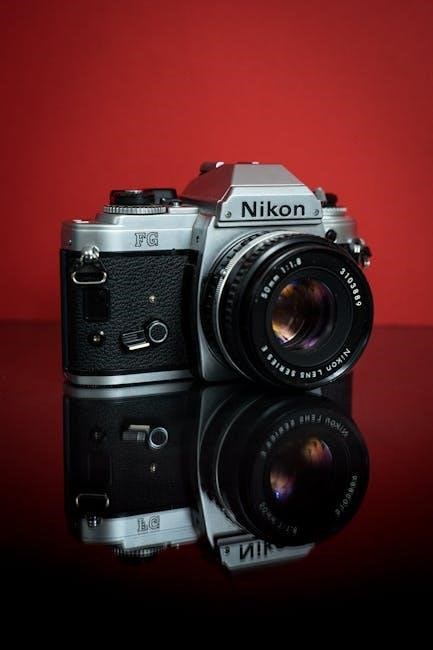The Nikon D3000 manual is your gateway to understanding and mastering this versatile DSLR camera. It covers everything from basic operations to advanced features, ensuring you make the most of your photography experience. The manual is available as a downloadable PDF or via the Nikon Manual Viewer 2 app, providing easy access to guides, troubleshooting, and customization options.
Overview of the Nikon D3000 Camera
The Nikon D3000 is a user-friendly DSLR camera designed for both beginners and enthusiasts. It features a 10.2-megapixel CCD sensor, capturing high-resolution images up to 3872 x 2592 pixels. The camera includes a 3-inch LCD display for easy preview and review of shots. Compatible with Nikon F-mount lenses, it offers versatility for various photography needs. The D3000 is equipped with an EXPEED image processing engine, ensuring excellent image quality and efficient performance. Its intuitive controls and Guide Mode make it an ideal choice for those transitioning from point-and-shoot to DSLR photography, providing a seamless learning curve.
Importance of the Nikon D3000 Manual
The Nikon D3000 manual is essential for unlocking the camera’s full potential. It provides detailed instructions on operating modes, menu functions, and custom settings, helping users optimize their photography experience. The manual also includes troubleshooting tips and maintenance guidelines, ensuring longevity and peak performance of the camera. Whether you’re a novice or an advanced photographer, the manual serves as a comprehensive guide, enabling you to explore advanced features like ISO sensitivity, white balance, and autofocus modes. Regular updates and firmware information are also covered, ensuring you stay informed about the latest enhancements for your D3000.
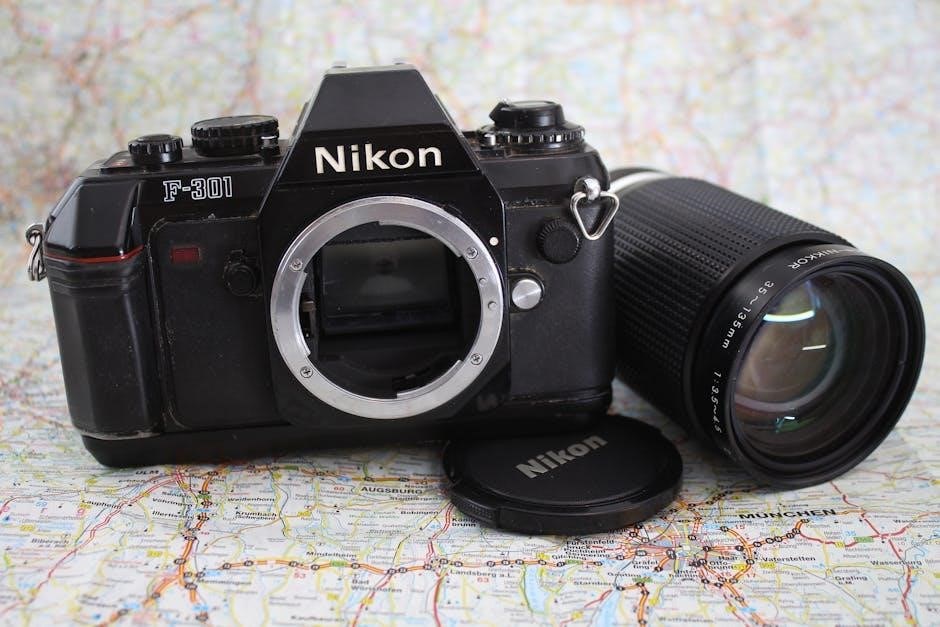
Downloading and Accessing the Nikon D3000 Manual
The Nikon D3000 manual can be downloaded as a PDF from Nikon’s official website or accessed via the Nikon Manual Viewer 2 app, ensuring easy reference anytime.
How to Download the Nikon D3000 PDF Manual
To download the Nikon D3000 PDF manual, visit Nikon’s official website and navigate to the support section. Select the D3000 model from the product list. Click on the “Manuals” or “Downloads” tab, then choose the PDF manual option. Save the file to your device and open it using Adobe Reader or similar software. Ensure you agree to any terms and conditions during the download process. The manual is also accessible via the Nikon Manual Viewer 2 app, available for iOS and Android devices, providing a convenient mobile option for reference.
Installing the Reference Manual from the CD
Insert the reference CD into your computer’s CD drive. Open the CD folder, typically named “Nikon D3000,” in your file explorer. Locate and double-click the “INDEX.pdf” file to launch the manual in your default PDF viewer. Select your preferred language from the menu to access the content. The manual is organized into sections, covering setup, camera operations, and advanced features. For Mac users, the CD icon may appear on the desktop; double-click it to access the manual. Ensure Adobe Reader or a compatible PDF viewer is installed to view the document properly.
Using the Nikon Manual Viewer 2 App
Download the Nikon Manual Viewer 2 app for iOS or Android to access the D3000 manual digitally. Once installed, launch the app and select your camera model. The app allows you to download and view the manual offline, with features like keyword search, bookmarks, and zoom for easy reading. Navigate through sections effortlessly, and refer to specific guides or troubleshooting tips on the go. This app is ideal for quick access to camera instructions without needing the physical manual or CD, making it a convenient tool for photographers of all skill levels. It enhances your learning and shooting experience with the Nikon D3000.
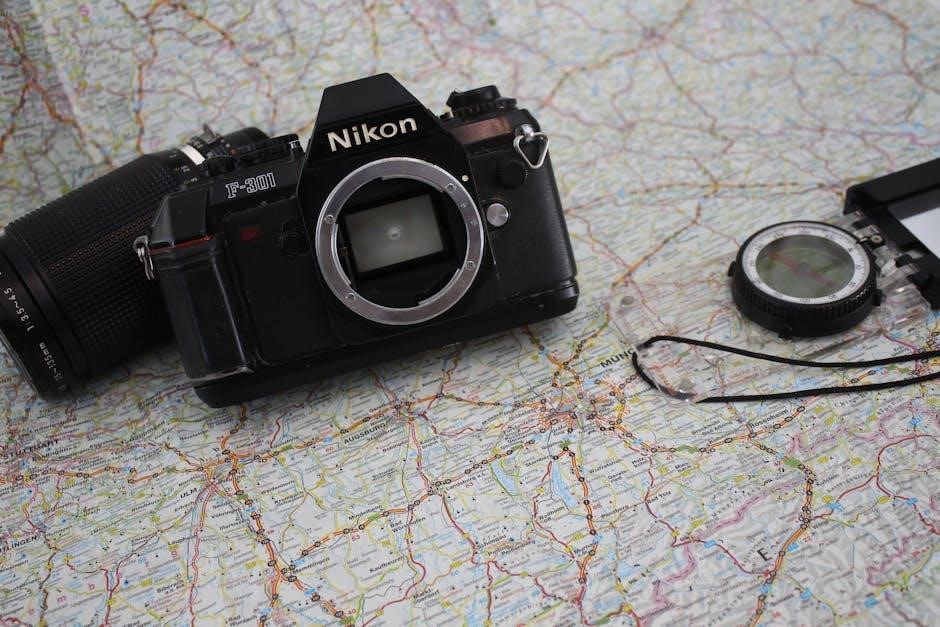
Key Sections of the Nikon D3000 Manual
The manual is divided into sections like Quick Start Guide, Basic Operations, Shooting Modes, Menu Functions, and Troubleshooting, ensuring comprehensive coverage of the camera’s features and usage.
Quick Start Guide for Beginners
The Quick Start Guide in the Nikon D3000 manual is designed to help new users quickly familiarize themselves with the camera’s essential features. It covers basic setup steps, such as charging the battery, mounting the lens, and inserting the memory card. The guide also explains fundamental camera modes, including Auto Mode for point-and-shoot photography and Guide Mode for interactive assistance. Additionally, it provides an overview of the camera’s controls and navigation menu, ensuring beginners can start capturing high-quality images immediately. This section is perfect for those looking to understand the camera’s basics without diving into advanced settings.
Basic Camera Operations and Controls
The Nikon D3000 manual details essential camera operations, starting with turning the camera on and navigating its intuitive controls. The Mode Dial allows switching between shooting modes, while the Release Mode Dial offers options like Single Frame or Continuous shooting. The multi-selector and buttons enable easy menu navigation and quick access to settings like ISO sensitivity and autofocus modes. Understanding these controls is crucial for capturing images effectively. The manual also explains the LCD display and viewfinder functionality, ensuring users can review and compose shots with precision. This section provides a solid foundation for mastering the camera’s fundamental operations, making photography more enjoyable and efficient.
Advanced Shooting Modes and Features
The Nikon D3000 manual highlights advanced shooting modes, including Manual (M), Shutter Priority (S), and Aperture Priority (A), offering full creative control. Scene Modes like Portrait, Landscape, and Night Portrait optimize settings for specific conditions. Custom Picture Controls allow users to adjust image styles, while white balance settings ensure accurate color representation. The manual also explains ISO sensitivity and noise reduction features for low-light photography. Autofocus modes, such as Single-Servo AF and Continuous-Servo AF, are detailed for precise subject tracking. These features empower photographers to refine their technique and capture professional-quality images with ease and precision.
Menu Functions and Custom Settings
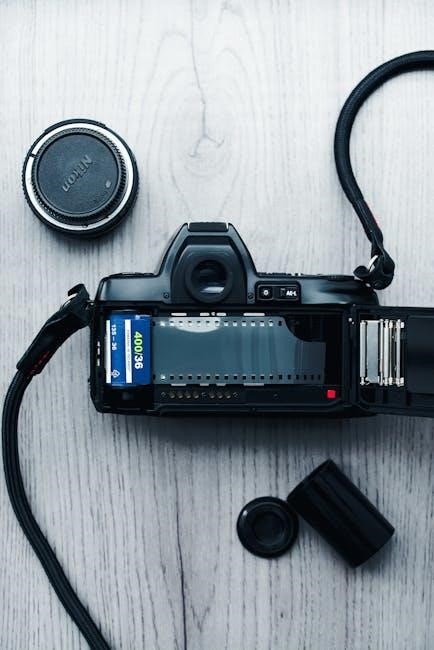
The Nikon D3000 manual provides detailed guidance on navigating and customizing the camera’s menu system. Users can access various settings, including autofocus modes, metering options, and ISO sensitivity, to tailor the camera to their preferences. Custom Settings allow for personalization of shooting parameters, such as AE-L/AF-L button functions and autofocus tracking. The manual explains how to adjust these settings for optimal performance in different photography scenarios. By mastering these menu functions, photographers can streamline their workflow and achieve consistent, high-quality results, making the most of the D3000’s advanced capabilities.
Troubleshooting Common Issues
The Nikon D3000 manual includes a dedicated section for troubleshooting common issues, helping users resolve problems efficiently. It addresses errors such as the camera not turning on, memory card errors, and autofocus malfunctions. Solutions range from resetting settings to cleaning the sensor and lens. The manual also provides guidance on updating firmware to fix bugs and improve performance. Additionally, it offers advice on maintaining the camera, such as using genuine Nikon accessories and avoiding damaged cards. By following these troubleshooting steps, users can quickly identify and resolve issues, ensuring uninterrupted photography sessions and optimal camera functionality.
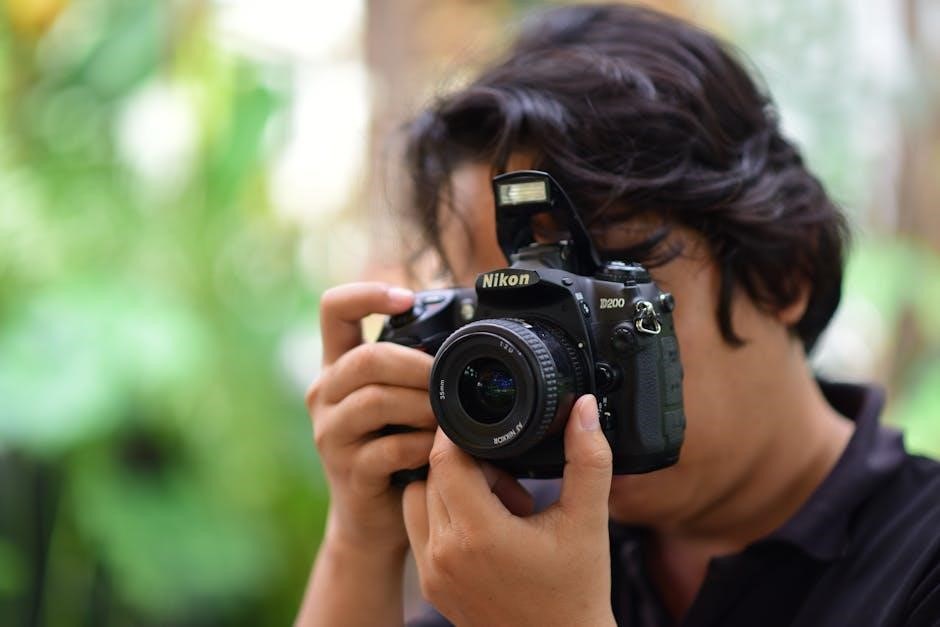
Understanding Camera Specifications
The Nikon D3000 features a 10.2-megapixel CCD sensor, capturing high-resolution images up to 3872 x 2592 pixels. Its 3-inch LCD display enhances image preview and review; Equipped with the Nikon F-mount, it supports a wide range of compatible lenses, offering versatility for diverse shooting needs.
10.2 Megapixel CCD Sensor and Image Resolution
The Nikon D3000 is equipped with a 10.2-megapixel CCD sensor, delivering high-quality images with a maximum resolution of 3872 x 2592 pixels. This sensor ensures detailed captures, vibrant colors, and excellent low-light performance. The CCD technology provides accurate color reproduction and minimal noise, making it ideal for both beginners and enthusiasts. With such resolution, users can print large photos or crop images without losing clarity. The sensor’s capabilities are further enhanced by Nikon’s image processing system, ensuring optimal results in various shooting conditions. This feature-rich sensor is a cornerstone of the D3000’s performance, offering versatility for diverse photography needs.
3-Inch LCD Display Features
The Nikon D3000 features a 3-inch LCD display, providing a clear and vibrant preview of your shots. This wide-screen monitor offers 230,000-dot resolution, making it easy to review images and videos with precise detail. The LCD supports various playback functions, including zoom, thumbnail viewing, and histogram display, which aids in assessing exposure levels. The display also supports live view shooting, allowing for precise composition. Additionally, the LCD’s wide viewing angle ensures visibility even when shooting from challenging angles. This feature enhances the overall usability of the camera, making it a valuable tool for photographers of all skill levels.
Nikon F Mount and Lens Compatibility
The Nikon D3000 is equipped with the Nikon F mount, ensuring compatibility with a wide range of Nikkor lenses. This versatility allows photographers to choose from an extensive selection of lenses, including wide-angle, telephoto, macro, and zoom options. The F mount supports AF-S, AF-D, and AF Nikkor lenses, enabling precise autofocus and optimal image quality. Additionally, the camera is compatible with Nikon’s DX-format lenses, which are specifically designed to maximize the performance of the D3000’s APS-C sensor. This compatibility provides users with the flexibility to explore various photographic styles and enhance their creative potential.
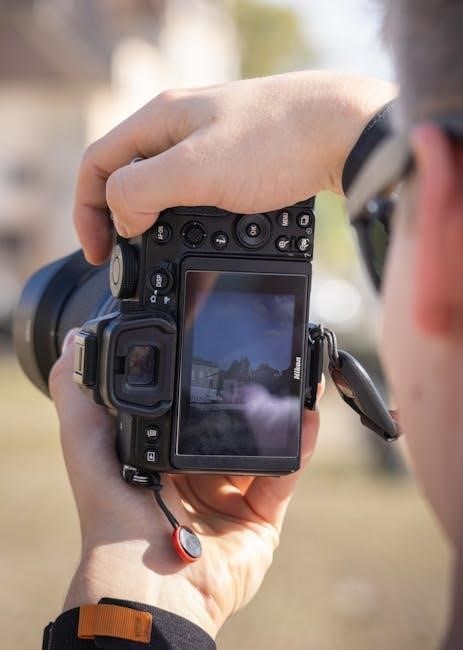
Mastering Shooting Modes
The Nikon D3000 offers versatile shooting modes, including Auto, Manual, and Scene modes, empowering photographers to capture stunning images in various conditions with precision and creativity.
Auto Mode for Point-and-Shoot Photography
The Nikon D3000’s Auto Mode simplifies photography, allowing users to capture stunning images effortlessly. This mode automatically adjusts exposure, autofocus, and ISO settings, making it ideal for beginners or quick snapshots. By eliminating manual adjustments, Auto Mode ensures that the camera optimizes settings for various shooting conditions, delivering balanced and high-quality results. While it limits creative control, Auto Mode is perfect for those who want to focus on composition and timing without worrying about technical details. It’s a great starting point for learning photography fundamentals before exploring more advanced modes.
Manual Mode for Full Creative Control
Manual Mode on the Nikon D3000 offers unparalleled creative freedom, allowing photographers to fully control aperture, shutter speed, and ISO settings. This mode is ideal for experienced users or enthusiasts seeking precise control over their images. By adjusting these parameters, photographers can achieve specific effects like depth of field, motion blur, or freeze action. The manual also provides guidance on understanding exposure compensation and using the built-in light meter for accurate results. While it requires a deeper understanding of photography principles, Manual Mode empowers users to express their artistic vision fully, making it a powerful tool for those who want to push their creative boundaries.
Scene Modes for Specific Shooting Conditions
The Nikon D3000 features Scene Modes tailored for various shooting scenarios, ensuring optimal results without manual adjustments. Modes like Portrait, Landscape, Child, Sports, Close-up, Night Portrait, and Auto adapt camera settings to suit the scene. Portrait mode softens backgrounds for sharp subject focus, while Landscape mode emphasizes depth and sharpness. Sports mode freezes fast-moving subjects, and Night Portrait balances flash with ambient light. These modes simplify photography by automatically adjusting aperture, shutter speed, and ISO for consistent results, making them ideal for photographers who want professional-looking images without complex manual controls.
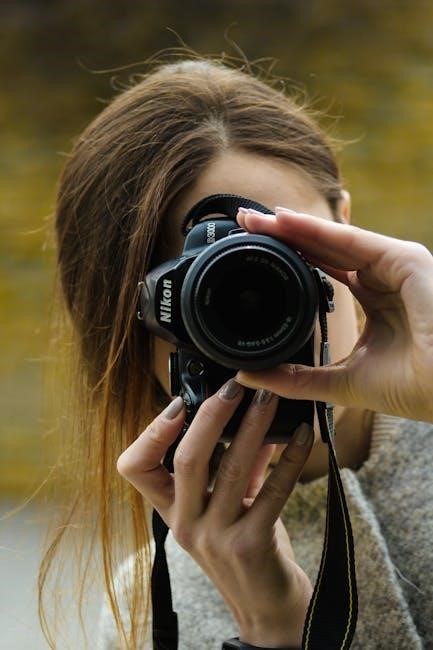
Advanced Features and Settings
The Nikon D3000 offers advanced features like ISO sensitivity control, noise reduction, and white balance adjustments. These settings enhance image quality and provide precise control over shooting conditions.
ISO Sensitivity and Noise Reduction
The Nikon D3000 manual details ISO sensitivity, ranging from 100 to 1600, with optional expansion to 6400 in Hi 1 mode. This feature is crucial for low-light photography, allowing clearer images without flash. Noise reduction settings are adjustable, minimizing grain in high ISO shots. The camera automatically applies noise reduction, but users can customize it for better results. Understanding ISO and noise reduction ensures optimal image quality in various lighting conditions, making it a key section for mastering the D3000’s capabilities. Proper use enhances detail and minimizes unwanted artifacts, providing professional-grade photography outcomes.
White Balance and Picture Controls
The Nikon D3000 manual explains how to adjust white balance for accurate color reproduction in various lighting conditions. Options include Auto, Daylight, Fluorescent, and Cloudy settings. Custom white balance allows precise adjustments for unique lighting scenarios. Picture Controls enable users to customize image parameters like sharpening, contrast, and color saturation. Choices include Standard, Neutral, Vivid, and Monochrome modes. These tools empower photographers to achieve consistent and desired color aesthetics. The manual provides step-by-step guidance on selecting and fine-tuning these settings, ensuring optimal image quality tailored to individual preferences or specific shooting environments.
Autofocus Modes and Metering Options
The Nikon D3000 manual details its autofocus modes, including AF-A (Auto-Servo AF), AF-S (Single-Servo AF), and AF-C (Continuous-Servo AF), each suited for different shooting scenarios. Metering options like Matrix, Center-weighted, and Spot metering help achieve precise exposure control. These features ensure sharp focus and balanced lighting, enhancing image quality. The manual guides users on selecting the right mode and metering option for various conditions, from dynamic action shots to stationary portraits, allowing for professional-level results with ease and precision.

Customizing Your Camera
Customizing your Nikon D3000 allows personalized shooting experiences. Set custom profiles, assign functions to buttons, and configure autofocus and metering preferences for tailored camera operation.
Setting Up Custom Shooting Profiles
Setting up custom shooting profiles on the Nikon D3000 enhances your photography workflow. These profiles allow you to save specific camera settings, such as ISO, white balance, and autofocus modes, for quick access during different shooting scenarios. By creating and storing these profiles, you can easily switch between setups for landscapes, portraits, or low-light conditions without adjusting each setting individually. This feature streamlines your process, ensuring you capture the perfect shot every time. The manual provides step-by-step guidance on creating, saving, and managing these profiles efficiently.
Assigning Functions to Camera Buttons
Assigning functions to camera buttons on the Nikon D3000 allows for personalized control, enhancing your shooting experience. Through the Custom Setting Menu, you can reassign buttons like AE-L/AF-L or Fn to functions such as metering mode, ISO sensitivity, or white balance. This customization enables quick access to frequently used settings, streamlining your workflow. Experiment with different assignments to suit your style, and remember to save changes to maintain your preferences. This feature ensures your camera adapts to your needs, making photography more efficient and intuitive.
Configuring Autofocus and Metering Preferences
Configuring autofocus and metering preferences on the Nikon D3000 allows you to tailor the camera to your shooting style. The autofocus system offers modes like AF-A (Auto-Servo), AF-C (Continuous), and AF-S (Single Servo) for precise subject tracking. Metering modes, including 3D Color Matrix, Center-Weighted, and Spot, can be adjusted for accurate exposure control. Access these settings through the Custom Setting Menu, where you can fine-tune options like AF-C priority and metering mode. This customization ensures optimal performance in various lighting conditions and subjects, helping you capture sharp, well-exposed images consistently.

Troubleshooting and Maintenance
Troubleshooting common issues like error messages, shutter problems, or sensor cleaning ensures optimal camera performance. Regular maintenance, such as cleaning the sensor and updating firmware, prevents malfunctions and enhances functionality.
Common Errors and Solutions
The Nikon D3000 manual addresses common errors such as “ERR” messages, which often indicate issues like lens or memory card problems. Solutions include cleaning the lens contacts, reformatting the memory card, or resetting the camera. Shutter malfunction errors (e.g., “Shutter” or “Mirror” errors) may require professional servicing. Autofocus issues can be resolved by recalibrating the lens or using live view mode. For sensor cleaning errors, manual cleaning or updating firmware may be necessary. Always refer to the troubleshooting guide in the manual for step-by-step solutions to restore optimal camera performance and resolve operational issues effectively.
Cleaning and Maintaining the Camera
Regular cleaning and maintenance are essential to keep your Nikon D3000 in optimal condition. Use a soft, dry cloth to wipe the camera body and lens, avoiding harsh chemicals. For the image sensor, use a bulb blower to remove dust, and for stubborn particles, refer to the manual for wet cleaning instructions. Clean the LCD screen with a microfiber cloth and avoid touching it to prevent smudges. Store the camera in a cool, dry place to prevent moisture damage. Regularly check and update firmware to ensure the camera functions smoothly. Proper maintenance extends the camera’s lifespan and ensures top performance for years to come.
Updating Firmware for Enhanced Performance
Updating the firmware on your Nikon D3000 ensures optimal performance, stability, and compatibility with the latest features and lenses. To update, connect your camera to a computer using the USB cable provided. Visit Nikon’s official website, navigate to the support section, and download the latest firmware version specific to your camera model. Follow the on-screen instructions carefully, ensuring the camera remains connected and powered throughout the process. Avoid interrupting the update, as this could cause permanent damage. Once complete, restart the camera to apply the new firmware. Regular updates are crucial for maintaining peak functionality and enjoying the full potential of your Nikon D3000.
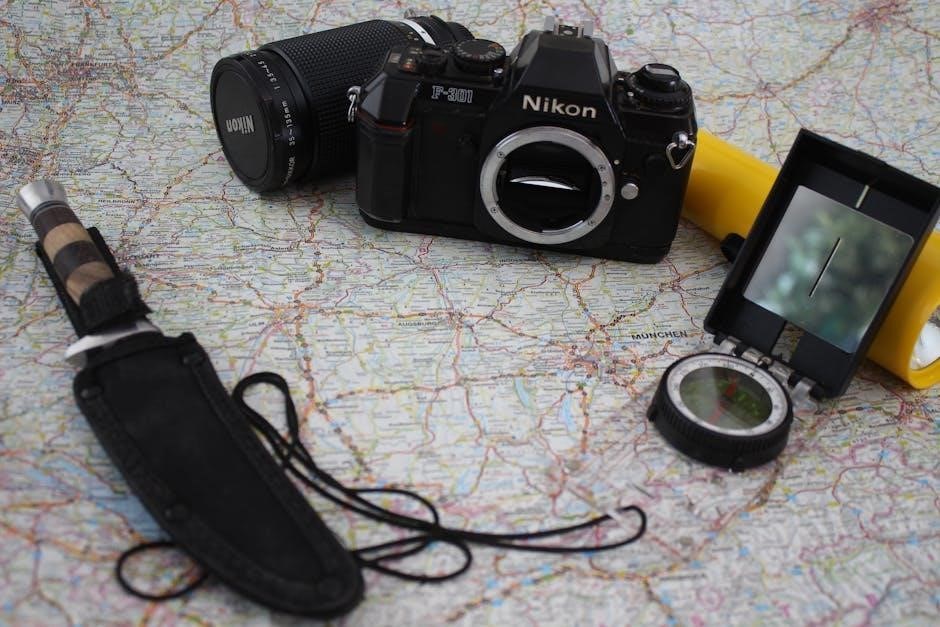
Additional Resources
Explore Nikon’s software tools like ViewNX-i and Capture NX-D for enhanced image editing. Join online forums for community support and discover recommended accessories to complement your Nikon D3000.
Nikon Software Tools (ViewNX-i, Capture NX-D)
Nikon offers powerful software tools to enhance your D3000 experience; ViewNX-i allows for easy image browsing, basic editing, and transfer to devices. Capture NX-D provides advanced RAW image processing, enabling precise adjustments to color, tone, and more. These tools help streamline your workflow and unlock creative potential, ensuring you get the most from your photos. Both are available for download, supporting Windows and macOS. Use them to refine your images and organize your library efficiently.
Online Communities and Forums for Support
Online communities and forums are invaluable resources for Nikon D3000 users. Platforms like Nikon Club Ufficiale and dedicated photography forums offer extensive support, where enthusiasts share knowledge and solutions. Users can discuss camera settings, troubleshooting, and creative techniques. These communities provide a space to learn from experts and enthusiasts, ensuring continuous improvement in photography skills. Additionally, Nikon’s official support pages and forums offer direct access to professional advice and updates, making them essential for maximizing your D3000 experience. Engaging with these communities fosters growth and helps photographers of all levels achieve their creative goals.
Recommended Accessories for the Nikon D3000
To enhance your Nikon D3000 experience, consider essential accessories like high-quality lenses, such as the AF-S DX NIKKOR 18-55mm and 55-200mm, for versatile shooting. Memory cards from trusted brands like SanDisk and Lexar ensure ample storage. An external flash unit, like the SB-700, improves lighting control. Remote shutter releases, such as the MC-DC2, reduce camera shake. Tripods and camera bags protect and stabilize your gear. Additionally, software tools like ViewNX-i and Capture NX-D help in editing and managing your photos. These accessories empower you to explore the full potential of your Nikon D3000 and elevate your photography to new heights.
The Nikon D3000 manual empowers photographers to master their camera, unlocking creative potential and enhancing imaging skills through comprehensive guidance and continuous learning opportunities.
Maximizing Your Nikon D3000 Experience
The Nikon D3000 manual is your key to unlocking the full potential of your camera. By exploring its advanced features, such as ISO sensitivity, white balance, and autofocus modes, you can achieve professional-grade results. Customizing shooting profiles and button functions allows for a personalized experience, while troubleshooting guides help resolve common issues. Utilizing resources like Nikon’s software tools and online communities further enhances your skills. Continuous learning and practice ensure you stay updated and improve your photography. With the D3000, every shot becomes an opportunity to capture stunning images, making it an essential companion for photographers of all levels.
Continuous Learning and Improvement
Continuous learning is key to mastering the Nikon D3000. The manual serves as a foundation, but exploring additional resources like Nikon’s software tools (ViewNX-i, Capture NX-D) and online forums enhances your skills. Regularly updating firmware ensures optimal performance. Engaging with Nikon’s community and practicing advanced techniques expands your creative possibilities. By combining theoretical knowledge with hands-on practice, you can refine your photography skills and adapt to new challenges, ensuring your Nikon D3000 experience remains rewarding and evolving over time.
